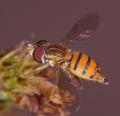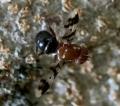Diptera.info :: Identification queries :: Diptera (adults)
Who is here? 1 guest(s)
|
[Sturmia bella] Masicera sphingivora ?
|
|
| pierred |
Posted on 17-01-2007 06:45
|
|
Member Location: Paris (France) Posts: 1448 Joined: 21.04.05 |
Hello, A leptidopterist found this fly in his chrysalids of Agrius convolvuli and thikns therefore that this should be Masicera sphingivora.  auteur inconnu : France : 16/1/2007 : nord is?re : 38460 altitude non renseign?e - taille non renseign?e ref=16019  auteur inconnu : France : 16/1/2006 : : 38460 altitude non renseign?e - taille non renseign?e ref=16020 Can somebody confirm or infirm? Thanks in advance. Edited by pierred on 27-01-2007 07:32 Pierre Duhem |
|
|
|
| Zeegers |
Posted on 17-01-2007 21:27
|
|
Member Location: Soest, NL Posts: 18921 Joined: 21.07.04 |
Not sure The pictures are not good enough to give a positive ID Theo Zeegers |
|
|
|
| pierred |
Posted on 18-01-2007 05:25
|
|
Member Location: Paris (France) Posts: 1448 Joined: 21.04.05 |
Theo, Thanks anyway. Pierre Duhem |
|
|
|
| pierred |
Posted on 19-01-2007 06:39
|
|
Member Location: Paris (France) Posts: 1448 Joined: 21.04.05 |
Theo, What would you need to see? The original poster has still the flies and could make other ones. Pierre Duhem |
|
|
|
| Nikita Vikhrev |
Posted on 19-01-2007 09:31
|
|
Member Location: Moscow, Russia Posts: 9425 Joined: 24.05.05 |
Hi Pierre. Alas, I can't help with ID so far. But I want to inform that couple weeeks ago I've got via "Pemberley Books" a very good Muscidae of Central Europe and that it is possible to order in same place (and I've ordered yet) also Fanniidae and SARCOPHAGIDAE of Centr Europe. Nikita Nikita Vikhrev - Zool Museum of Moscow University |
|
|
|
| ChrisR |
Posted on 19-01-2007 09:56
|
|
Super Administrator Location: Reading, England Posts: 7703 Joined: 12.07.04 |
Hi Pierre, We'd need a much closer/clearer view of the bristles on the thorax, scutellum & abdomen; plus the face from the front; mid-tibia; and possibly other angles too - depending on how the key works  |
| pierred |
Posted on 22-01-2007 05:57
|
|
Member Location: Paris (France) Posts: 1448 Joined: 21.04.05 |
Here are some more pictures : auteur inconnu : France : 17/1/2007 : : 38460 altitude non renseign?e - taille non renseign?e ref=16070  auteur inconnu : France : 17/1/2007 : : 38460 altitude non renseign?e - taille non renseign?e ref=16071  auteur inconnu : France : 17/1/2007 : : 38460 altitude non renseign?e - taille non renseign?e ref=16072 I hope it will help. Pierre Duhem |
|
|
|
| Zeegers |
Posted on 23-01-2007 18:41
|
|
Member Location: Soest, NL Posts: 18921 Joined: 21.07.04 |
The more picutres I see, the less it seems Masicera. Could we please get a pic of the head from above, another one in profile (from side) and of the hind tibia ? I know, we ask a lot Thanks Theo |
|
|
|
| pierred |
Posted on 24-01-2007 06:29
|
|
Member Location: Paris (France) Posts: 1448 Joined: 21.04.05 |
Hello, I'll ask the original poster to do those pictures and will come back. thanks anyway, Theo. Pierre Duhem |
|
|
|
| Zeegers |
Posted on 24-01-2007 19:53
|
|
Member Location: Soest, NL Posts: 18921 Joined: 21.07.04 |
Good. Please try to get the light better. Photos are either to dark, unsharp or flashed at crucial parts. We really need to be positive whether the eyes are hairy or bare and whether discal setae on tergites are present. Thanks Theo |
|
|
|
| pierred |
Posted on 25-01-2007 05:37
|
|
Member Location: Paris (France) Posts: 1448 Joined: 21.04.05 |
Theo, Here are the pictures du jour :  auteur inconnu : France : 24/1/2007 : : 38460 altitude non renseign?e - taille non renseign?e ref=16166  auteur inconnu : France : 24/1/2007 : : 38460 altitude non renseign?e - taille non renseign?e ref=16167  auteur inconnu : France : 24/1/2007 : : 38460 altitude non renseign?e - taille non renseign?e ref=16168 Hope that helps. Pierre Duhem |
|
|
|
| Zeegers |
Posted on 25-01-2007 19:49
|
|
Member Location: Soest, NL Posts: 18921 Joined: 21.07.04 |
Thanks This helps It 100 % NOT sphingivora. And my gut feeling yesterday was right it is Sturmia bella. Surprise, surprise, since the common hort of Sturmia is Nymphalidae. Is your source sure of the host ? No mixup ? Theo Zeegers |
|
|
|
| ChrisR |
Posted on 26-01-2007 02:36
|
|
Super Administrator Location: Reading, England Posts: 7703 Joined: 12.07.04 |
oh oh oh ... with a bristle-comb that obvious even I can ID that one  |
| pierred |
Posted on 26-01-2007 07:09
|
|
Member Location: Paris (France) Posts: 1448 Joined: 21.04.05 |
Hello, Zeegers wrote: Is your source sure of the host ? No mixup ? Thanks. I'll ask. Pierre Duhem |
|
|
|
| Zeegers |
Posted on 26-01-2007 09:37
|
|
Member Location: Soest, NL Posts: 18921 Joined: 21.07.04 |
Hi Chris To go hear you agree. Once I suspected it might be Sturmia, I knew what I was looking for. And there it was.... Theo |
|
|
|
| ChrisR |
Posted on 26-01-2007 11:05
|
|
Super Administrator Location: Reading, England Posts: 7703 Joined: 12.07.04 |
Well, going by Tschorsnig (1994): bristle comb is regular without any larger bristles mixed into it (Masicera comes off a couplet which says it has irregular bristles on the hind tibia and Townsendiellomyia has a comb but 1 large bristle too); it looks like it has 2 inner orbital bristles but actually the first is smaller (in Masicera there would be 2-3 inner orbitals, the anterior one being strong). Shouldn't be Blepharipa either because the second antennal segment seems black (Blepharipa is yellow).  So, it would be nice to have the specimen in-hand (blah, blah, blah) but ... it looks pretty damn good for Sturmia bella  The only problem is the host (as you said) ... I don't think I'd take a record for a non-nymphalid host (or at least a non-butterfly) without a lot of proof that the collector didn't accidentally mix his pupae in the same cage.  |
| Zeegers |
Posted on 26-01-2007 20:38
|
|
Member Location: Soest, NL Posts: 18921 Joined: 21.07.04 |
Hi Chris I did compare with several specimens in my collection, I have no doubt it is Sturmia. If you look closely at the picture, there is only 1 pair of inner orbitals. Your 'second one' is actually the other one of the same pair. This is an important feature. This specimen was very confusing, because * ocellar bristles seemed absent * apical scutellar bristles seems erect. All, no doubt, artifical, however, this is impossible to see from the pictures. In hand, it would have been easier. Blepharipa has yellow palpi. Masicera sphingivora has in the male sex 2 pairs of external proclinate orbitals, which is here out of the question. My apologies to all members not familiar with all these bristles. Theo Zeegers |
|
|
|
| Susan R Walter |
Posted on 28-01-2007 00:39
|
|
Member Location: Touraine du Sud, central France Posts: 1802 Joined: 14.01.06 |
If unfamiliar terms have not made it to the glossary yet, you can now go to the Online Dictionary of Invertebrate Zoology that I have submitted as a new web link (in Miscellaneous). Trawling through it I am quite surprised to see how many terms are peculiar to dipterology. Susan |
| pierred |
Posted on 28-01-2007 07:19
|
|
Member Location: Paris (France) Posts: 1448 Joined: 21.04.05 |
Hello, Chris Raper wrote:The only problem is the host (as you said) ... I don't think I'd take a record for a non-nymphalid host (or at least a non-butterfly) without a lot of proof that the collector didn't accidentally mix his pupae in the same cage. I asked the original poster whether he was sure about everything he had said. Here is his answer: la confusion me semble improbable: - suite ? l'emmergence de la premi?re mouche, j'ai mis le reste des pupes (25-30) dans un flacon ? pr?levement. Ensuite, J'ai bien pris un specimen de ce flacon pour les photographies - je n'?l?ve pas de Nymphalidae en ce moment: mes seules chrysalides en ?levage sont ? l'ext?rieur de la maison dans des cages et ils sagit d'un noctuidae de genre Catocala (chrys. intacte) de Papilio alexanor (encore 5 chrys. intactes), 1 Arctia caja (intacte) Raw translation : A confusion doesn't seem possible: - following the emergence of the first fly, I put the rest of pupae (25-30) in a container. Then I took a specimen from this container for the photos. - I don't rear Nymphalidae at this time: the only reared chrysalids are outside the house in cages: they are Noctuidae, genus Catocala (intact chrysalid), Papilio alexanor (5 more intact chrys.), 1 Arctia caja (intact). Pierre Duhem |
|
|
|
| Zeegers |
Posted on 28-01-2007 20:44
|
|
Member Location: Soest, NL Posts: 18921 Joined: 21.07.04 |
Hi Pierre Good to be (more) sure. My critical approach is based on many earlier experiences, in which original claims of hosts did not hold when critically reviewed. Sturmia bella is a typical Tachinidae for Nymphalidae, but it has been reared occasionally from other larger caterpillars. So this one can be seen as yet another exception. Thanks Theo |
|
|
|
| Jump to Forum: |













